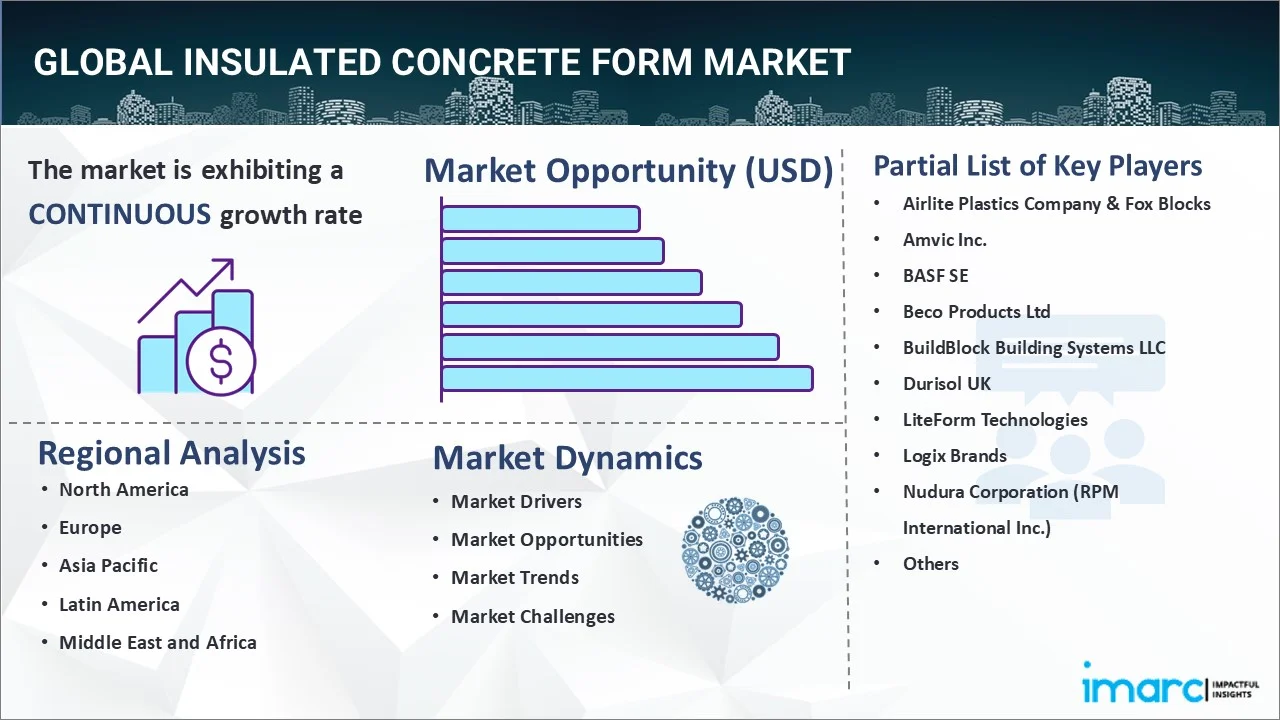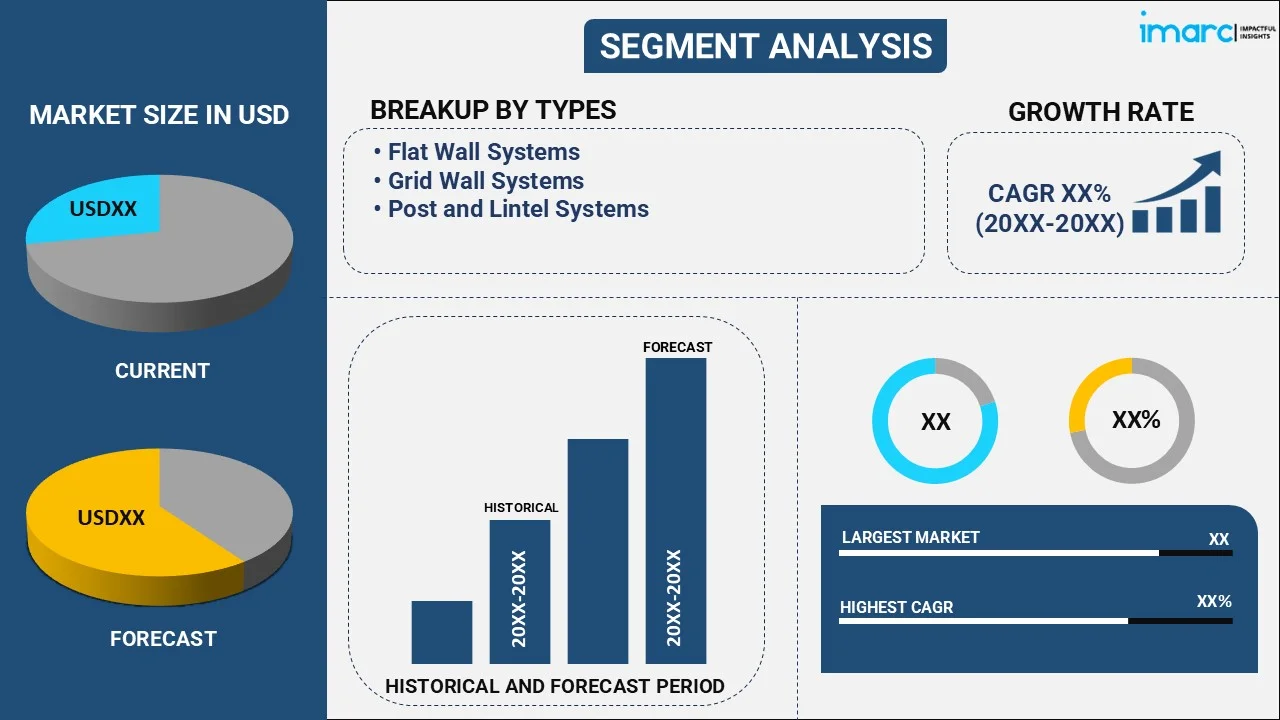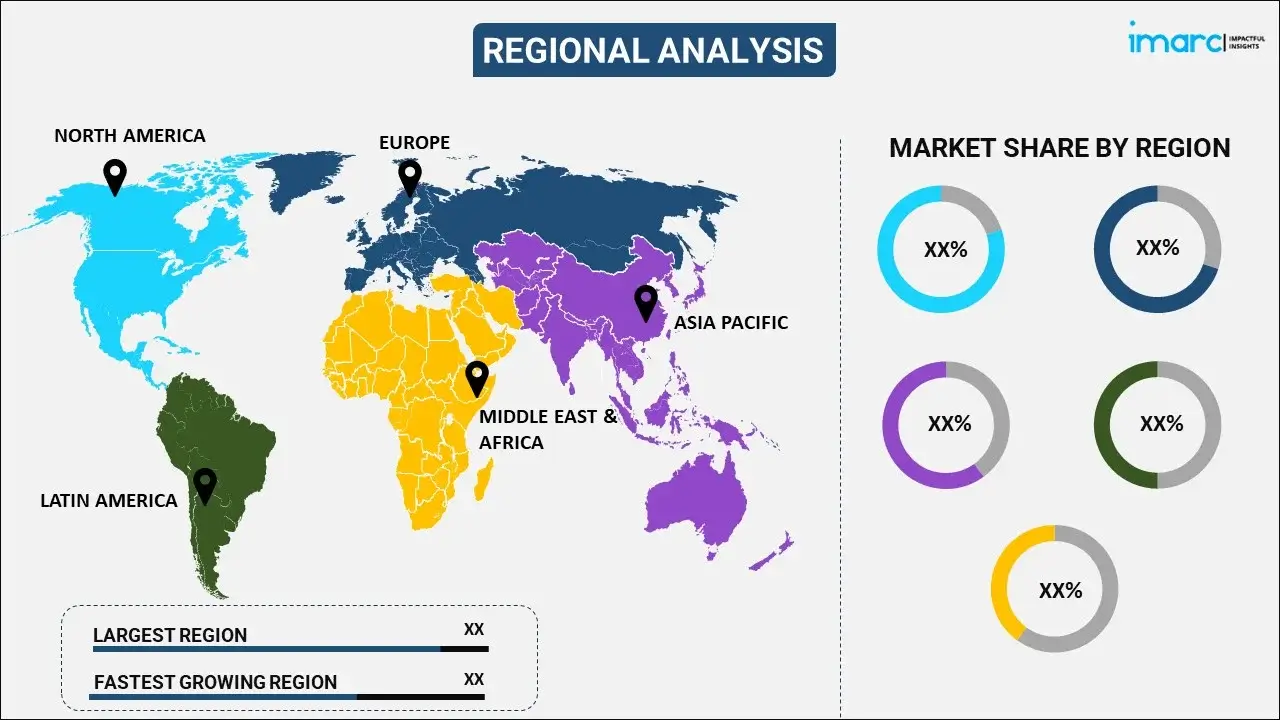
Insulated Concrete Form Market Report by Type (Flat Wall Systems, Grid Wall Systems, Post and Lintel Systems), Material (Polystyrene Foam, Polyurethane Foam, and Others), End Use (Residential, Non-Residential), and Region 2025-2033
Market Overview:
The global insulated concrete form (ICF) market size reached USD 1,015.6 Million in 2024. Looking forward, IMARC Group expects the market to reach USD 1,486.1 Million by 2033, exhibiting a growth rate (CAGR) of 4.32% during 2025-2033. The growing emphasis on energy efficiency and sustainability in the construction industry, rising concerns for disaster resilience and safety, and continuous advancements in material technology are some of the major factors propelling the market growth.
|
Report Attribute
|
Key Statistics
|
|---|---|
|
Base Year
|
2024
|
|
Forecast Years
|
2025-2033
|
|
Historical Years
|
2019-2024
|
|
Market Size in 2024
|
USD 1,015.6 Million |
|
Market Forecast in 2033
|
USD 1,486.1 Million |
| Market Growth Rate (2025-2033) | 4.32% |
Insulated concrete form (ICF) is a construction system consisting of hollow, lightweight blocks or panels made from materials, such as expanded polystyrene (EPS) foam and other insulating materials. It exhibits insulating properties and helps in maintaining consistent indoor temperatures and reducing energy consumption. It provides excellent resistance to fire, wind, and impacts, enhancing the overall durability of the building. It reduces heat loss or gain, leading to lower energy bills for heating and cooling. It allows for faster construction compared to traditional methods, reducing labor costs and project timelines. It is widely used in residential homes to offer energy-efficient, quiet, and durable living spaces.

Rapid urbanization and increasing construction of residential and commercial buildings are facilitating the market growth. Additionally, the rising need for renovating and replacing aging infrastructure is driving the demand for ICFs in retrofitting projects to improve energy efficiency. Apart from this, the governing authorities of several countries are offering financial incentives, grants, or tax credits to encourage energy-efficient building practices, which include the use of ICFs. Furthermore, homebuyers and commercial property occupants are increasingly seeking energy-efficient and environmentally friendly buildings, making ICFs an attractive option. Moreover, the pursuit of green building certifications like Leadership in Energy and Environmental Design (LEED) and Energy Star is promoting the adoption of ICF across the globe.
Insulated Concrete Form (ICF) Market Trends/Drivers:
Rising emphasis on energy efficiency and sustainability
The growing emphasis on energy efficiency and sustainability in the construction industry represents one of the primary factors catalyzing the demand for ICF systems. Additionally, the rising focus of individuals and businesses on reducing carbon emissions and minimizing the environmental impact of buildings is driving the demand for efficient ICFs. Apart from this, the governing authorities and regulatory bodies in many regions are introducing incentives and mandates to promote energy-efficient building practices. This includes offering tax incentives and rebates for builders and homeowners who choose ICF construction. These incentives act as a catalyst for the adoption of ICF technology, further propelling the market growth.
Increasing disaster resilience and safety concerns
The increasing concern for disaster resilience and safety in construction is another major factor strengthening the growth of the market. Climate change is leading to more frequent and severe weather events, such as hurricanes, tornadoes, and wildfires, posing a significant threat to buildings and their occupants. ICFs offer superior strength and durability. The solid concrete core in ICF walls provides excellent resistance to various hazards, including fire, wind, and impacts. This makes buildings constructed with ICFs more resilient and better equipped to withstand natural disasters. As a result, architects, engineers, and developers are turning to ICFs to design and build structures that can better withstand the challenges posed by an unpredictable climate.
Advancements in ICF technology and design
Advancements in ICF technology and design represent the third significant factor driving market growth. Additionally, the expansion of the construction industry is propelling ICF manufacturers to continually innovate to meet the changing needs of builders and architects. Apart from this, manufacturers are developing ICFs with integrated features, such as built-in attachment points for electrical and plumbing systems. These innovations streamline the construction process, reduce labor costs, and enhance the overall efficiency of ICF construction. Furthermore, advancements in material technology are leading to improved insulation properties, making ICFs more energy efficient. New materials and construction methods are reducing the environmental impact of ICF production, aligning with sustainability goals.
Insulated Concrete Form (ICF) Industry Segmentation:
IMARC Group provides an analysis of the key trends in each segment of the market report, along with forecasts at the global, regional, and country levels from 2025-2033. Our report has categorized the market based on type, material and end use.
Breakup by Type:

- Flat Wall Systems
- Grid Wall Systems
- Post and Lintel Systems
Flat wall systems account for the majority of the market share
The report has provided a detailed breakup and analysis of the market based on the type. This includes flat wall systems, grid wall systems, and post and lintel systems. According to the report, flat wall systems represented the largest segment due to their cost-effectiveness. These systems are easy to install and require less labor and material compared to more complex architectural forms. Additionally, they offer flexibility and allow architects and builders to incorporate various finishes, textures, and architectural details to create visually appealing facades. Apart from this, the materials used in flat wall systems can be sourced sustainably, and their energy-efficient properties contribute to reduced energy consumption in buildings, making them an environmentally responsible choice. Furthermore, they can easily incorporate modern building technologies, such as insulation and energy-efficient features. This adaptability allows builders to meet evolving energy codes and sustainability requirements.
Breakup by Material:
- Polystyrene Foam
- Polyurethane Foam
- Others
Polystyrene foam holds the largest share in the industry
A detailed breakup and analysis of the market based on the material has also been provided in the report. This includes polystyrene foam, polyurethane foam, and others. According to the report, polystyrene foam accounted for the largest market share due to its exceptional properties and applications. It has a high R-value, which measures its thermal resistance. This property makes it an ideal choice for insulation applications in construction, helping to reduce heat transfer and maintain consistent indoor temperatures. Apart from this, it provides cushioning and protection for fragile items during shipping while keeping packaging weight to a minimum, reducing shipping costs and environmental impact. Furthermore, it can be molded, cut, and shaped into a wide range of forms and sizes. This versatility allows it to serve diverse applications, from insulation panels in construction to intricate packaging inserts and even artistic sculptures.
Breakup by End Use:
- Residential
- Non-Residential
Residential dominates the market
The report has provided a detailed breakup and analysis of the market based on the end use. This includes residential and non-residential. According to the report, residential holds the majority of the market share due to the intrinsic and evolving needs of individuals and families for a safe and secure place to live, sleep, and raise their families. This fundamental necessity ensures a constant demand for residential properties, leading to market dominance. Apart from this, continuous population growth drives the construction of new residential units. Furthermore, residential properties are often considered stable and reliable investment opportunities. Many individuals and investors purchase residential real estate to generate rental income or benefit from property appreciation. Moreover, the desire for more eco-friendly living spaces drives the construction of new residential developments to meet evolving preferences. In addition, various technological advancements in construction and home automation are enhancing the appeal of residential properties.
Breakup by Region:

- North America
- United States
- Canada
- Asia-Pacific
- China
- Japan
- India
- South Korea
- Australia
- Indonesia
- Others
- Europe
- Germany
- France
- United Kingdom
- Italy
- Spain
- Russia
- Others
- Latin America
- Brazil
- Mexico
- Others
- Middle East and Africa
North America leads the market, accounting for the largest insulated concrete form (ICF) market share
The market research report has also provided a comprehensive analysis of all the major regional markets, which include North America (the United States and Canada); Asia Pacific (China, Japan, India, South Korea, Australia, Indonesia, and others); Europe (Germany, France, the United Kingdom, Italy, Spain, Russia, and others); Latin America (Brazil, Mexico, and others); and the Middle East and Africa. According to the report, North America accounted for the largest market share due to the availability of financial resources in North America that allow for investment in innovative construction methods. ICF offers numerous benefits, like energy efficiency, reduced maintenance costs, and the potential for government incentives making it an economically viable choice in the long run. Apart from this, the governing agencies and local authorities in the United States and Canada are proactive in promoting energy-efficient building practices and are implementing stringent energy codes and building standards to reduce carbon emissions and energy consumption. In addition to energy-related regulations, North American regions are susceptible to various natural disasters, including hurricanes and wildfires. As a result, building codes in these areas often require structures to be resilient against such hazards.
Competitive Landscape:
ICF manufacturers are investing in research and development to create innovative ICF products. They are designing new block shapes and sizes, improving insulation properties, and developing integrated features to enhance the efficiency of construction. Additionally, many companies are adopting sustainable manufacturing practices. This includes using eco-friendly materials and processes, reducing waste, and minimizing the carbon footprint of their products. Apart from this, they are exploring new geographic markets to expand their customer base. They are targeting regions with growing construction industries and a focus on energy-efficient and sustainable building practices. Furthermore, several companies are providing education and training programs for architects, builders, and contractors. These programs aim to familiarize professionals with ICF technology and best practices for construction.
The market research report has provided a comprehensive analysis of the competitive landscape. Detailed profiles of all major companies have also been provided. Some of the key players in the market include:
- Airlite Plastics Company & Fox Blocks
- Amvic Inc.
- BASF SE
- Beco Products Ltd
- BuildBlock Building Systems LLC
- Durisol UK
- LiteForm Technologies
- Logix Brands
- Nudura Corporation (RPM International Inc.)
- Polycrete International
- Quad-Lock Building Systems
- Sunbloc Ltd.
(Please note that this is only a partial list of the key players, and the complete list is provided in the report.)
Recent Developments:
- In September 2022, Amvic Inc. launched the Amvic ICF system, an expanded polystyrene (EPS) building block (graphite enhanced) with unique properties like modular interlocking and flame retardance.
- In October 2020, Durisol UK announced that the construction work for the first phase of an exciting new Cambridgeshire housing development for which the company will be supplying the primary construction material.
- In March 2021, Logix Brands published new Logix ICF engineering for Canada and the USA to reflect the new design and building code requirements in the US and Canada.
Insulated Concrete Form (ICF) Market Report Scope:
| Report Features | Details |
|---|---|
| Base Year of the Analysis | 2024 |
| Historical Period | 2019-2024 |
| Forecast Period | 2025-2033 |
| Units | Million USD |
| Scope of the Report | Exploration of Historical Trends and Market Outlook, Industry Catalysts and Challenges, Segment-Wise Historical and Future Market Assessment:
|
| Types Covered | Flat Wall Systems, Grid Wall Systems, Post and Lintel Systems |
| Materials Covered | Polystyrene Foam, Polyurethane Foam, Others |
| End Uses Covered | Residential, Non-Residential |
| Regions Covered | Asia Pacific, Europe, North America, Latin America, Middle East and Africa |
| Countries Covered | United States, Canada, Germany, France, United Kingdom, Italy, Spain, Russia, China, Japan, India, South Korea, Australia, Indonesia, Brazil, Mexico |
| Companies Covered | Airlite Plastics Company & Fox Blocks, Amvic Inc., BASF SE, Beco Products Ltd, BuildBlock Building Systems LLC, Durisol UK, LiteForm Technologies, Logix Brands, Nudura Corporation (RPM International Inc.), Polycrete International, Quad-Lock Building Systems, Sunbloc Ltd., etc. |
| Customization Scope | 10% Free Customization |
| Post-Sale Analyst Support | 10-12 Weeks |
| Delivery Format | PDF and Excel through Email (We can also provide the editable version of the report in PPT/Word format on special request) |
Key Benefits for Stakeholders:
- IMARC’s industry report offers a comprehensive quantitative analysis of various market segments, historical and current market trends, market forecasts, and dynamics of the insulated concrete form (ICF) market from 2019-2033.
- The research report provides the latest information on the market drivers, challenges, and opportunities in the global insulated concrete form (ICF) market.
- The study maps the leading, as well as the fastest-growing, regional markets. It further enables stakeholders to identify the key country-level markets within each region.
- Porter's five forces analysis assist stakeholders in assessing the impact of new entrants, competitive rivalry, supplier power, buyer power, and the threat of substitution. It helps stakeholders to analyze the level of competition within the insulated concrete form (ICF) industry and its attractiveness.
- Competitive landscape allows stakeholders to understand their competitive environment and provides an insight into the current positions of key players in the market.
Key Questions Answered in This Report
The global insulated concrete form (ICF) market was valued at USD 1,015.6 Million in 2024.
We expect the global insulated concrete form (ICF) market to exhibit a CAGR of 4.32% during 2025-2033.
The rising installation of insulated concrete form across the residential, industrial, and commercial buildings, owing to its thermal, fire, and disaster resistance properties is primarily driving the global insulated concrete form (ICF) market.
The sudden outbreak of the COVID-19 pandemic had led to the implementation of stringent lockdown regulations across several nations resulting in the temporary halt in numerous construction activities, thereby limiting the demand for Insulated Concrete Form (ICF).
Based on the type, the global insulated concrete form (ICF) market can be categorized into flat wall systems, grid wall systems, and post and lintel systems. Currently, flat wall systems exhibit clear dominance in the market.
Based on the material, the global insulated concrete form (ICF) market has been segmented into polystyrene foam, polyurethane foam, and others. Among these, polystyrene foam represents the largest market share.
Based on the end use, the global insulated concrete form (ICF) market can be bifurcated into residential and non-residential. Currently, the residential sector accounts for the majority of the total market share.
On a regional level, the market has been classified into North America, Europe, Asia-Pacific, Middle East and Africa, and Latin America, where North America currently dominates the global market.
Some of the major players in the global insulated concrete form (ICF) market include Airlite Plastics Company & Fox Blocks, Amvic Inc., BASF SE, Beco Products Ltd, BuildBlock Building Systems LLC, Durisol UK, LiteForm Technologies, Logix Brands, Nudura Corporation (RPM International Inc.), Polycrete International, Quad-Lock Building Systems, and Sunbloc Ltd.
Need more help?
- Speak to our experienced analysts for insights on the current market scenarios.
- Include additional segments and countries to customize the report as per your requirement.
- Gain an unparalleled competitive advantage in your domain by understanding how to utilize the report and positively impacting your operations and revenue.
- For further assistance, please connect with our analysts.
 Request Customization
Request Customization
 Speak to an Analyst
Speak to an Analyst
 Request Brochure
Request Brochure
 Inquire Before Buying
Inquire Before Buying




.webp)




.webp)












